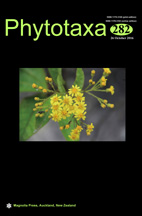Abstract
A new ophiostomatoid species, Ophiostoma olgensis sp. nov., isolated from Larix olgensis and Larix gmelini infested by Ips subelongatus in northern China, is described and illustrated. The fungus produces abundant short-necked perithecia in phloem as well as on artificial substrates. The short-necked perithecia are characteristic of the Ophiostoma minus complex and more specifically, of Ophiostoma kryptum, isolated from European larch. However, O. olgensis can be distinguished from O. kryptum on the basis of combined morphological traits and phylogenetic data from ITS, partial β-tubulin, EF-1α, and actin gene region analyses of single-spore isolates. The most obvious morphological differences between both species are the asexual forms and the conidial morphology. The pathogenicity of O. olgensis and O. kryptum was evaluated in situ on local mature Larix spp. by stem inoculation. All inoculations of O. olgensis and O. kryptum resulted in serious lesions on the inner bark, and thus the new species is considered to be a pathogen on Larix spp. (L. olgensis, L. gmelini, L. principis-rupprechtii and L. kaempferi ).

